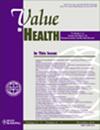量化德国的低价值医疗:使用 2018 年至 2021 年法定医疗保险数据进行观察研究。
IF 4.9
2区 医学
Q1 ECONOMICS
引用次数: 0
摘要
目标:低价值医疗是指其收益不足以抵消成本和潜在危害的医疗服务。本研究估算了德国公共医疗系统中 24 种低价值医疗服务的流行程度、分布情况和相关成本:使用 Techniker Krankenkasse(TK)提供的法定医疗保险数据进行大规模回顾性观察研究,时间跨度为 2018 年至 2021 年,每年覆盖约 1110 万名投保人。研究计算了 24 项低价值服务指标的流行率,这些指标是通过系统回顾和专家咨询确定的。为了解决区分适当护理和低价值护理的不确定性问题,对所有适当的指标都采用了广义(可能高估)和狭义(可能低估)的定义,提供了一个范围,预计低价值护理的真实程度就在这个范围内:结果:2019 年至 2021 年期间,通过使用 24 项指标,确定有 160 万患者接受了至少一项低价值服务。在接受检查的所有 1060 万个已交付服务(病例)中,平均每年有 110 万个病例(广义定义)和 43 万个病例(狭义定义)被归类为低价值,分别占 10.4% 和 4.0%。确定的服务每年产生的费用约为 1550 万欧元(广义)和 990 万欧元(狭义):尽管德国法定医疗保险数据存在局限性,但在 24 项低价值指标中的几项指标中发现了相当多的低价值医疗服务。结论:尽管德国法定医疗保险数据存在局限性,但在 24 项低价值指标中,有几项都发现了大量低价值医疗。研究结果突出表明,有必要在德国采取有针对性的干预措施来减少低价值医疗,从而指导医疗政策和实践,有效提高医疗质量和安全性。本文章由计算机程序翻译,如有差异,请以英文原文为准。
Quantifying Low-Value Care in Germany: An Observational Study Using Statutory Health Insurance Data From 2018 to 2021
Objectives
Low-value care refers to medical services whose benefits do not outweigh the costs and potential harm. This study estimates the prevalence, distribution, and associated costs of 24 low-value care services within the German public healthcare system.
Methods
This study was designed as a large-scale retrospective observational study using statutory health insurance data provided by the Techniker Krankenkasse, spanning from 2018 to 2021, covering approximately 11.1 million insured individuals annually. The prevalence of 24 low-value service indicators, which were identified through a systematic review and expert consultations, was calculated. To address uncertainties in distinguishing between appropriate and low-value care, both broad (potential overestimation) and narrow definitions (potential underestimation) were applied to all suitable indicators, providing a range within which the true extent of low-value care is expected to lie.
Results
Between 2019 and 2021, 1.6 million patients were identified as having received at least 1 low-value service using the 24 indicators. Of all 10.6 million delivered services (cases) evaluated, on average per year, 1.1 million cases (broad definition) and 0.43 million cases (narrow definition) were classified as low-value care, corresponding to 10.4% and 4.0%, respectively. The costs incurred by the identified services were approximately euros €15.5 million (broad definition) and €9.9 million (narrow definition) annually.
Conclusions
Despite the limitations of German statutory health insurance data, considerable low-value care was found within several of the 24 low-value indicators. The findings highlight the necessity for targeted interventions to mitigate low-value care in Germany, guiding healthcare policy and practice to enhance quality and safety effectively.
求助全文
通过发布文献求助,成功后即可免费获取论文全文。
去求助
来源期刊

Value in Health
医学-卫生保健
CiteScore
6.90
自引率
6.70%
发文量
3064
审稿时长
3-8 weeks
期刊介绍:
Value in Health contains original research articles for pharmacoeconomics, health economics, and outcomes research (clinical, economic, and patient-reported outcomes/preference-based research), as well as conceptual and health policy articles that provide valuable information for health care decision-makers as well as the research community. As the official journal of ISPOR, Value in Health provides a forum for researchers, as well as health care decision-makers to translate outcomes research into health care decisions.
 求助内容:
求助内容: 应助结果提醒方式:
应助结果提醒方式:


